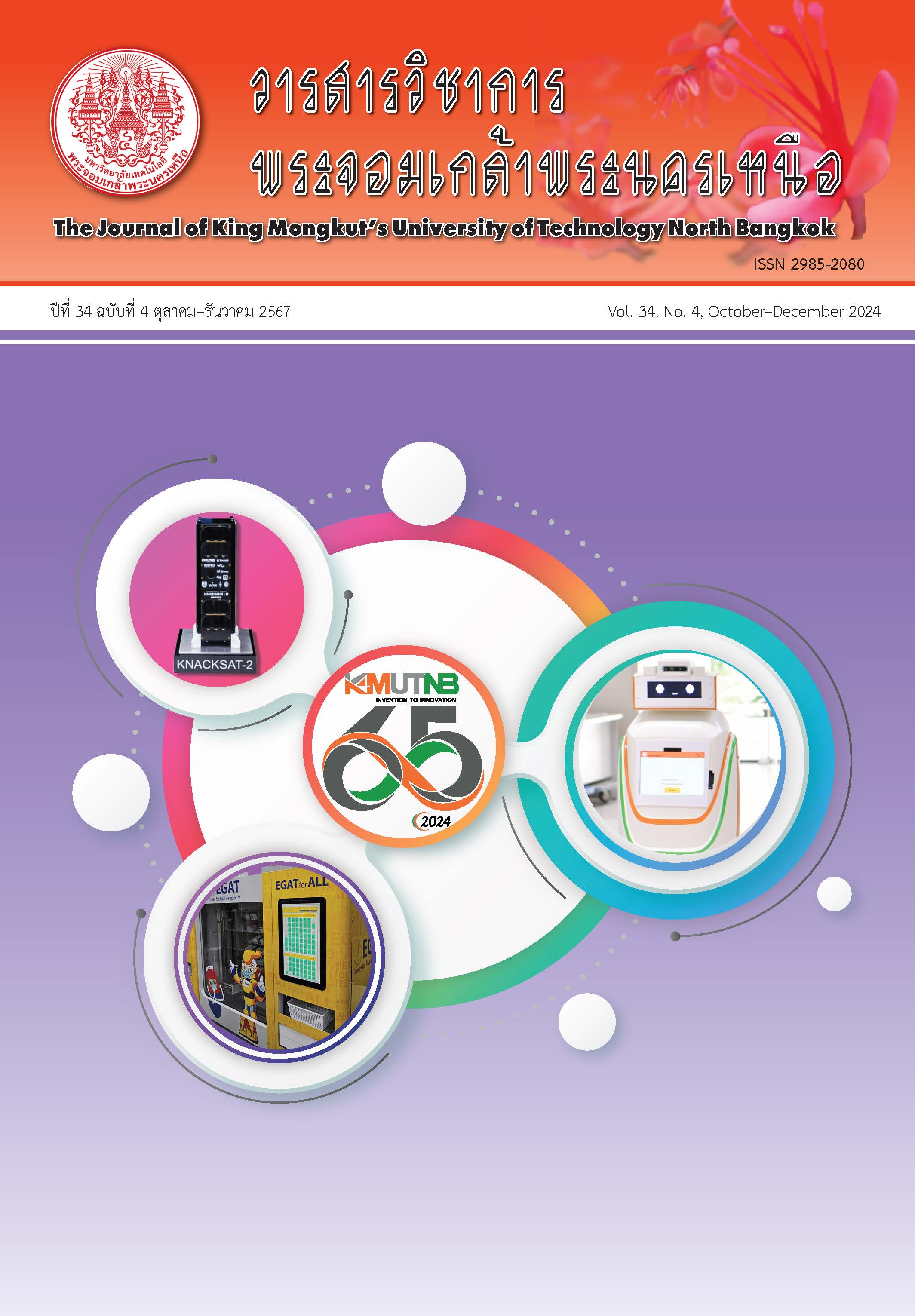การเพิ่มสมรรถนะของอาร์เรย์โมดูลเซลล์แสงอาทิตย์ภายใต้เงื่อนไขการบังเงาบางส่วนโดยใช้เทคนิคซูโดกุ 5×5 แบบกากบาทในจัดเรียงตำแหน่งโมดูล
Main Article Content
บทคัดย่อ
บทความนี้นำเสนอการเพิ่มสมรรถนะของอาร์เรย์โมดูลเซลล์แสงอาทิตย์ภายใต้เงื่อนไขการบังเงาบางส่วนลดผลกระทบจากการบังเงาบางส่วนโดยการกระจายรูปแบบการบังเงาด้วยการจัดเรียงตำแหน่งของโมดูลใหม่โดยคงตำแหน่งการเชื่อมต่อทางไฟฟ้าไว้ ซึ่งใช้เทคนิคซูโดกุ 5×5 แบบกากบาท จำนวน 5 รูปแบบ ได้แก่ SD1, SD2, SD3, SD4 และ SD5 เปรียบเทียบกับการจัดเรียงแบบ TCT มาตรฐาน ทำการศึกษาโดยใช้พารามิเตอร์ของแผงเซลล์แสงอาทิตย์ ชนิดโพลีคริสตัลไลน์ พิกัด 10 วัตต์ (VP-SP-10Wp) เชื่อมต่อโมดูลแบบ TCT การบังเงา 5 รูปแบบ ได้แก่ SW, SN, LW, LN และแบบไม่มีการบังเงา โดยโมดูลที่ถูกบังเงาและไม่มีเงาบังกำหนดให้ได้รับความเข้มรังสีดวงอาทิตย์ 300 วัตต์/ม.2 และ 1,000 วัตต์/ม.2 ตามลำดับที่อุณหภูมิโมดูล 25 องศาเซลเซียส จำลองหาพารามิเตอร์สำหรับวิเคราะห์หาสมรรถนะของอาร์เรย์โมดูลเซลล์แสงอาทิตย์บนโปรแกรม MATLAB/Simulink จากผลการจำลองพบว่า การจัดเรียงด้วยเทคนิคที่นำเสนอสามารถเพิ่มสมรรถนะของอาร์เรย์โมดูลเมื่อเปรียบเทียบกับการจัดเรียงแบบ TCT Std. ในกรณีการบังเงาบางส่วนแบบ SW SN และ LW ได้ 22.9 4.29 และ 18.63 เปอร์เซ็นต์ ตามลำดับ ในกรณีการจัดเรียงแบบ SD5 สามารถเพิ่มสมรรถนะการบังเงาแบบ LW ได้ 21.81 เปอร์เซ็นต์ ซึ่งแสดงให้เห็นว่า เทคนิคที่นำเสนอสามารถลดผลกระทบจากการบังเงาบางส่วนได้ ผลจากการวิจัยนี้สามารถนำรูปแบบการจัดเรียงที่นำเสนอไปใช้ในติดตั้งอาร์เรย์เซลล์แสงอาทิตย์เพื่อช่วยลดผลกระทบจากการบังเงาบางส่วนได้อย่างมีประสิทธิผล
Article Details

อนุญาตภายใต้เงื่อนไข Creative Commons Attribution-NonCommercial-NoDerivatives 4.0 International License.
บทความที่ลงตีพิมพ์เป็นข้อคิดเห็นของผู้เขียนเท่านั้น
ผู้เขียนจะต้องเป็นผู้รับผิดชอบต่อผลทางกฎหมายใดๆ ที่อาจเกิดขึ้นจากบทความนั้น
เอกสารอ้างอิง
T. Namhormchan, “Comparative study of enhanced power generation photovoltaic array under partial shading conditions using magic square row shifting technique,” EAUHJSci, vol. 15, no. 2, pp. 247–261, 2021 (in Thai).
A. de S. Lima, A. V. S. Moreira, A. L. Mai telli and L. S. Barros, “Maximum power point tracking through magic square for photovoltaic modules under partial shading,” in Proceedings 2019 IEEE PES Innovative Smart Grid Technologies Conference - Latin America (ISGT Latin America), 2019, pp. 1–6,
T. Namhormchan, “Comparative study of PV array performance from array topologies under partial shading using magic square row shifting technique,” EAUHJSci, vol. 15, no. 3, pp. 84–104, 2021 (in Thai).
V. P. Madhanmohan, M. Nandakumar, and A. Saleem, “Enhanced performance of partially shaded photovoltaic arrays using diagonally dispersed total cross tied configuration,” Energy Sources, Part A: Recovery, Utilization, and Environmental Effects, pp. 1–19, 2020.
K. Rajani and T. Ramesh, “Maximum power enhancement under partial shadings using a modified Sudoku reconfiguration,” CSEE Journal of Power and Energy Systems, vol. 7, no. 6, pp. 1187–1201, 2021.
V. Bala Raju, and Ch. Chengaiah, “Performance analysis of conventional, hybrid and optimal PV array configurations of partially shaded modules,” International Journal of Engineering and Advanced Technology (IJEAT), vol. 9, no. 1, pp. 3061–3073, 2019.
D. B. Mishra, R. Mishra, K. N. Das, A. A. Acharya, “Solving Sudoku puzzles using evolutionary techniques—A systematic survey,” in Soft Computing: Theories and Applications. Advances in Intelligent Systems and Computing, vol 583. Springer, Singapore, (2018).
V. Deshpande, and S. B. Bodkhe, “Ant colony optimization for optimal photovoltaic array reconfiguration under partial shading condition,” International Research Journal of Engineering and Technology (IRJET), vol. 4, no. 12, pp. 1402–1410, 2017.
H. S. Sahu and S. K. Nayak, “Extraction of maximum power from a PV array under nonuniform irradiation conditions,” IEEE Transactions on Electron Devices, vol. 63, no. 12, pp. 4825–4831, 2016.
G. Sai Krishna and T. Moger, “Improved SuDoKu reconfiguration technique for total-cross-tied PV array to enhance maximum power under partial shading conditions,” Renewable and Sustainable Energy Reviews, vol. 109, pp. 333–348, 2019.

